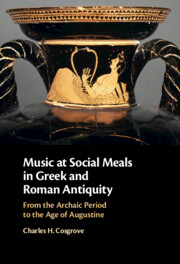Book contents
- Music at Social Meals in Greek and Roman Antiquity
- Music at Social Meals in Greek and Roman Antiquity
- Copyright page
- Dedication
- Contents
- Figures
- Glossary of Musical Instruments
- Abbreviations
- Introduction The Topic and the Sources
- Chapter 1 Sympotic Scenes and Songs
- Chapter 2 The Gentleman’s Lyre
- Chapter 3 Hellenistic Evolutions
- Chapter 4 Poets and Musicians at Upper-Class Greek Banquets
- Chapter 5 Music and Elite Dining in the Roman Age
- Chapter 6 Music at the Social Recreations of the Lower Classes
- Chapter 7 Music at the Suppers and Feasts of the Jewish People
- Chapter 8 Music at Christian Social Meals
- Chapter 9 Purposes and Pleasures
- Bibliography
- Index Locorum
- Subject Index
Chapter 6 - Music at the Social Recreations of the Lower Classes
Published online by Cambridge University Press: 18 November 2022
- Music at Social Meals in Greek and Roman Antiquity
- Music at Social Meals in Greek and Roman Antiquity
- Copyright page
- Dedication
- Contents
- Figures
- Glossary of Musical Instruments
- Abbreviations
- Introduction The Topic and the Sources
- Chapter 1 Sympotic Scenes and Songs
- Chapter 2 The Gentleman’s Lyre
- Chapter 3 Hellenistic Evolutions
- Chapter 4 Poets and Musicians at Upper-Class Greek Banquets
- Chapter 5 Music and Elite Dining in the Roman Age
- Chapter 6 Music at the Social Recreations of the Lower Classes
- Chapter 7 Music at the Suppers and Feasts of the Jewish People
- Chapter 8 Music at Christian Social Meals
- Chapter 9 Purposes and Pleasures
- Bibliography
- Index Locorum
- Subject Index
Summary
Nonelites made their own music and were also consumers of music performed by professionals in various settings. These included not only the private parties of the lower classes but public banquets at festivals and recreation in drink shops and the like, as well as the banquets held by voluntary associations to which nonelites belonged. The recreations of the lower classes took on larger public and political significance at festivals and their associated public banquets. Wealthy people and rulers used public entertainments to curry favor with the public and promote a public image of themselves. Rulers did the same. These public entertainments included banquets in theaters and amphitheaters where food and wine were served, sometimes in a fashion that amounted to a kind of mass dinner theater. This custom began with snacks and wine being provided to theatergoers in fifth-century Athens and seems to have mushroomed into something grander by the late Hellenistic era. The style was adopted by certain emperors, and one imperial format was a public banquet held in an arena where musical entertainments were provided and the gladiatorial matches and beast fights and hunts were also accompanied by music.
Keywords
- Type
- Chapter
- Information
- Music at Social Meals in Greek and Roman AntiquityFrom the Archaic Period to the Age of Augustine, pp. 223 - 264Publisher: Cambridge University PressPrint publication year: 2022



